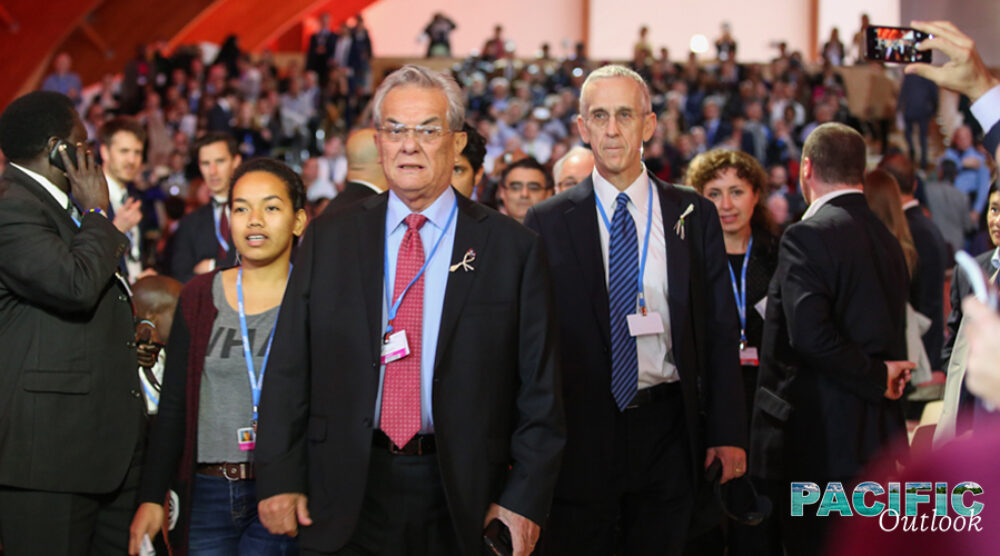Today, the Griffith Asia Institute launches a new blog series that explores the road to the COP26 UN climate summit, to be held in Glasgow in November. This series will feature voices from the Pacific and Australia, including diplomats, negotiators, academics and activists. It will unpack the key issues, key players, and key milestones before this pivotal climate summit. In the first of this series, Wesley Morgan considers the role Pacific island countries play in global climate diplomacy and explains why COP26 is such an important moment.
Pacific climate diplomacy: Shaping the global response to the climate crisis
Pacific island countries are uniquely exposed to the impacts of a warming world, including stronger cyclones, devastating floods, rising seas, dying reefs and ocean acidification. Pacific island leaders have declared climate change is the ‘single greatest threat’ they face. But Pacific states are not passive victims of the climate crisis. Pacific island countries are also shaping global cooperation on climate change. Working through coalitions with other nations, especially small island states in the Caribbean, Pacific countries have shaped UN negotiations for global rules to reduce emissions. For example, the first draft of the 1997 Kyoto Protocol – a UN treaty that required emissions reduction by wealthy nations – was put forward by Nauru ambassador Marlene Moses on behalf of the Alliance of Small Island States (AOSIS).
A major breakthrough came in 2015 with the negotiation of the Paris Agreement, the first truly global climate treaty. The Paris Agreement may never have been concluded without the determined diplomacy of Pacific island states. In the lead up to the Paris climate summit, the Marshall Islands played an especially important role, stitching together a coalition of countries that spanned the traditional negotiating blocs in the UN climate talks. The ‘High Ambition Coalition’, formed and led by the Marshall Islands’ foreign minister the late Tony De Brum, came to comprise more than 100 countries, and it was this coalition that secured the terms of the Paris Agreement. As US President Obama told island leaders in Hawaii in September 2016 “we could not have gotten a Paris Agreement without the incredible efforts and hard work of the island nations … they made an enormous difference”.
The road to COP26: Why the Glasgow summit is so important
Under the terms of the Paris Agreement all countries must, every five years, set more ambitious targets to reduce emissions. It is by this means that countries will work together to decarbonise the global economy and limit dangerous warming. Coming five years after the Paris Agreement (with a one-year-delay due to the COVID19 pandemic), COP26 is a critically important test of international cooperation to tackle the climate crisis. The future of the planet is literally at stake. Current Paris commitments have us tracking for more than 3°C of warming by the end of this century – a death sentence for low-lying Pacific island countries and a catastrophic outcome for countries like Australia. More ambitious national targets must be set before November. As the US Presidential Envoy for Climate John Kerry explains, failing to commit to new climate action would be “tantamount to a mutual suicide pact”.
So, in this crucial year for action, Pacific island countries want polluting nations to set new targets to reduce emissions over the next decade and commit to achieving net-zero emissions by 2050. They also want wealthy countries to meet their commitments to provide climate finance to poorer nations, especially through the Green Climate Fund. Pacific island states are joined by major powers like the UK, the US, and the EU, who are also pressing countries to make new commitments before COP26. As John Kerry explains: “all nations must raise ambition together – or we will all fail together [and] failure is not an option”. Growing pressure for action presents a challenge for countries like Australia, which has not set a new Paris target, has not committed to net-zero by 2050, and has withdrawn from the Green Climate Fund.
The road to COP26 is marked by a series of multilateral summits, where expectations will be high for countries to make new climate commitments. On April 22, US President Joe Biden will host a Climate Leaders’ Summit bringing together the world’s major economies, comprising collectively 80% of global emissions, and leaders from vulnerable nations, including President David Kabua from the Marshall Islands (as chair of the High Ambition Coalition). Biden will announce a new US Paris target for 2030 and wants other states to follow suit by announcing their own. Then in June comes the G7 Summit hosted by the UK, where Boris Johnson will work with leaders from some of the world’s wealthiest countries to coordinate action on carbon border taxes, a global phase-out of coal, and climate finance for poorer countries. In August, Fiji will host the 2021 Pacific Islands Forum, a key regional milestone on the road to COP26. Fiji’s prime minister Voreqe Bainimarama has already said he wants all members of the Pacific Islands Forum – including Australia – to commit to net-zero emissions by 2050, as part of a regional ‘2050 Strategy for the Blue Pacific’ to be launched at the Forum.
This year, climate change moves to the centre stage of global politics. Australia’s island neighbours will be working with some of the world’s most powerful countries to press for more ambitious climate action. Countries will need to respond by showing they too are serious about tackling the climate crisis, or they risk being sidelined on the road to COP26.
Dr Wesley Morgan is a Research Fellow at the Griffith Asia Institute. This article has been written for the Road to COP26 series for the Climate Action Beacon.








